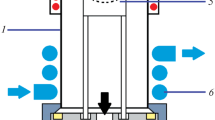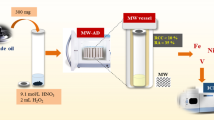Abstract—
In this paper, we report the development of a unified inductively coupled plasma atomic emission spectrometry technique that allows one to assess the purity of T 000 metallic tellurium. The process comprises two sequential steps: hydrometallurgical processing of electric filter dust concentrate, based on a classic hydrometallurgical scheme of processing anode slime from copper production, and electrolytic tellurium extraction followed by reducing–refining melting for the preparation of metallic tellurium. For high-speed analytical monitoring of the preparation of T 000 tellurium, we have developed an atomic emission spectrometry technique; chosen analytical lines, the inductively coupled plasma power, and an optimal-compromise matrix component concentration; and evaluated the adequacy of the proposed technique. No high-speed versatile techniques for chemical analysis of metallic tellurium, intermediate products differing in purity, or raw materials have been previously reported in the literature. The proposed technique allows one to determine up to 61 analytes with limits of detection (LODs) in the range from n × 10–7 to n × 10–4 wt % and intralaboratory precision better than 25%. Information about analyte concentrations obtained using the proposed technique allows one to optimize technologically important process parameters, draw conclusions regarding the quality of raw materials, and infer whether the final product—metallic tellurium—corresponds to grade T 000. The data we present on the chemical composition of the final product, intermediate products, and raw materials clearly demonstrate effectiveness of each step in the proposed scheme for the preparation of pure tellurium.




Similar content being viewed by others
REFERENCES
Makuei, F.M. and Senanayake, G., Extraction of tellurium from lead and copper bearing feed materials and interim metallurgical products – a short review, Miner. Eng., 2018, vol. 115, pp. 79–87. https://doi.org/10.1016/j.mineng.2017.10.013
Bureau, B. et al., Tellurium based glasses: a ruthless glass to crystal competition, Solid State Sci., 2008, vol. 10, no. 4, pp. 427–433. https://doi.org/10.1016/j.solidstatesciences.2007.12.017
Zaiour, A. et al., Electrical properties study of three highly purified CdTe ingots, Phys. Procedia, 2014, vol. 55, pp. 470–475. https://doi.org/10.1016/j.phpro.2014.07.068
Zaiour, A., Hamié, A., and Hage-Ali, M., Segregation study of some impurities in three purification process of CdTe ingots, Phys. Procedia, 2014, vol. 55, pp. 464–469. https://doi.org/10.1016/j.phpro.2014.07.067
Del Sordo, S. et al., Progress in the development of CdTe and CdZnTe semiconductor radiation detectors for astrophysical and medical applications, Sens. Mol. Diversity Preservation Int., 2009, vol. 9, no. 5, pp. 3491–3526. https://doi.org/10.3390/s90503491
Liu, H. et al., Purification of Cd0.9Zn0.1Te by physical vapor transport method, Mater. Lett., 2005, vol. 59, nos. 29–30, pp. 3837–3840. https://doi.org/10.1016/j.matlet.2005.06.059
Wang, T., et al., Study on the behaviors of impurities in cadmium zinc telluride, J. Cryst. Growth, 2007, vol. 304, no. 2, pp. 313–316. https://doi.org/10.1016/j.jcrysgro.2007.03.013
Horn, W., Földvari, I., and Denz, C., Holographic data storage in photorefractive bismuth tellurite, J. Phys. D: Appl. Phys., 2008, vol. 41, no. 22, pp. 1–9. https://doi.org/10.1088/0022-3727/41/22/224006
Földvári, I. et al., Bismuth tellurite – a new material for holographic memory, Opt. Commun., 2000, vol. 177, no. 1, pp. 105–109. https://doi.org/10.1016/S0030-4018(00)00560-5
Koudelka, L. et al., The structural role of tellurium dioxide in lead borophosphate glasses, J. Non.-Cryst. Solids, 2014, vol. 401, pp. 124–128. https://doi.org/10.1016/j.jnoncrysol.2014.01.044
Pujari, N. et al., Effect of Li2O content on structural and optical properties of Li2O–TeO2–As2O3–B2O3 glasses, J. Phys. Chem. Solids, 2021, vol. 148, pp. 124–128. https://doi.org/10.1016/j.jpcs.2020.109627
Kudryavtsev, A.A., Khimiya i tekhnologiya selena i tellura (Chemistry and Technology of Selenium and Tellurium), Moscow: Vysshaya Shkola, 1961.
Chizhikov, D.M. and Schastlivyi, V.P., Tellur i telluridy (Tellurium and Tellurides), Moscow: Nauka, 1966.
GOST (State Standard) 17614-2018: Commercially Pure Tellurium. Technical Specifications (Corrected), 2018.
GOST (State Standard) 24977.2-81: High-Purity Tellurium. Spectral Determination of Impurities, 1981.
Zaksas, N.P., Komissarova, L.N., and Shelpakova, I.R., Atomic emission spectral analysis of high-purity tellurium oxide with excitation of spectra in a two-jet arc plasma generator, Anal. Kontrol’, 2005, vol. 9, no. 3, pp. 240–244.
Shaverina, A.V., Tsygankova, A.R., and Saprykin, A.I., A procedure of ICP-AES analysis of silicon using microwave digestion and preconcentration, J. Anal. Chem., 2015, vol. 7, no. 1, pp. 28–31. https://doi.org/10.1134/S1061934815010153
ACKNOWLEDGMENTS
We are grateful to V.V. Yatsunov, managing director of LLC SibKhimTekhnologii.
Funding
This work was supported by the Russian Federation Ministry of Science and Higher Education (state research target for the Nikolaev Institute of Inorganic Chemistry, Siberian Branch, Russian Academy of Sciences, in the field of basic research, project no. 121031700315-2).
Author information
Authors and Affiliations
Corresponding author
Ethics declarations
The authors declare that they have no conflicts of interest.
Rights and permissions
About this article
Cite this article
Lundovskaya, O.V., Tsygankova, A.R., Orlov, N.A. et al. Analytical Support for the T 000 Tellurium Preparation Process. Inorg Mater 58, 990–998 (2022). https://doi.org/10.1134/S0020168522090102
Received:
Revised:
Accepted:
Published:
Issue Date:
DOI: https://doi.org/10.1134/S0020168522090102




